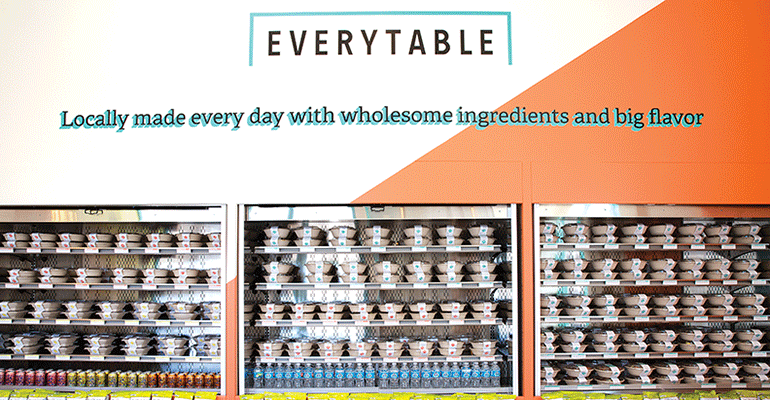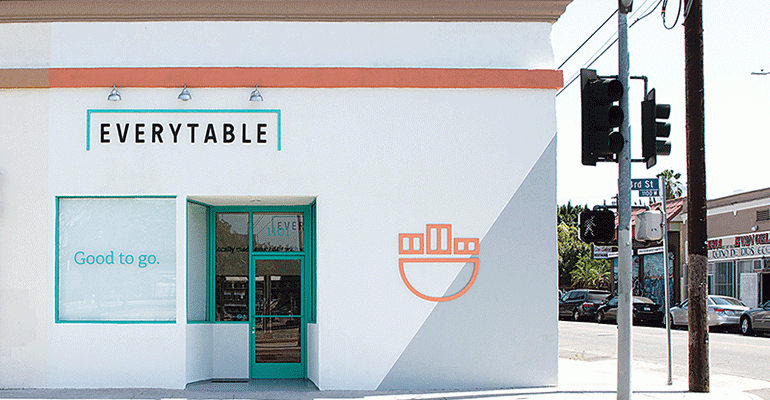It’s not a mirage. Those little storefronts popping up in impoverished areas of Los Angeles really are oases of fresh, healthful, low-cost meals in the city’s “food deserts,” neighborhoods where quality options are largely absent.
Everytable, a for-profit foodservice operation with a philanthropic mission, seeks to serve areas that otherwise have limited access to fresh, affordable food. Its unique business model revolves around keeping costs and prices as low as possible to break even — or eke out a slight profit — in low-income areas, while charging more for the same dishes in higher-income areas.
Prices are in the $4 to $5 range in its two outlets in low-income South L.A., for example, while in the more upscale area of downtown Los Angeles, an Everytable location charges around $8 for the same items, all made in bulk at a central commissary. A fourth location — Everytable’s second in a higher-income area — is slated to open within weeks in Santa Monica, Calif.
In order to fulfill its mission, Everytable prioritizes efficiencies throughout its operation, from procurement to the point of sale.
“We made a couple of decisions early on that we felt were important for keeping costs low,” said David Foster, cofounder of Everytable. “One of those decisions was to have it be a plant-based, ingredient-forward menu. That helps with both cost and health.”
Everytable seeks to provide hearty, filling meals — up to about 12 to 16 ounces per serving — but it limits the meat-based ingredients to a few ounces of lean chicken or other proteins. Trend-forward items such as the California Cobb salad and Puebla Chicken Tinga compare with what diners might expect to find at a mainstream fast-casual restaurant.
The menu also adheres to strict nutritional guidelines, said CEO Sam Polk, who cofounded Everytable with Foster.
“We wanted to provide something you could eat every single day and still be as healthy as you possibly could be,” he said.

Before Foster and Polk launched Everytable, they had both been involved in Groceryships, a nonprofit that seeks to address the lack of access to fresh, affordable food at the retail level.
At Everytable, a key decision Foster and Polk made early on was to keep the menu as simple as possible, and to cross-utilize ingredients. Multiple dishes use the same kale and cabbage blend, for example.
The goal was to be able to have just enough variety to be able to create 10 to 14 different dishes per day. Plans call for a few new items to be introduced seasonally and rotated into the mix to keep the menu interesting and capitalize on seasonal variability in ingredient pricing.
Everytable targets costs of about $3.85 to produce each meal, including ingredients, labor and store overhead costs. Pricing is designed to produce a small margin for potential profits in the food desert stores and a more generous margin in the stores located in higher-income areas.
Cross-utilizing ingredients also helps contain labor costs, allowing a small number of kitchen personnel to produce large batches of ingredients used across multiple dishes. A Mexican-style stewed chicken, for example, takes the same number of people to prepare it, “whether you are making 10 portions or 100 portions,” said Foster.
The commissary model and cross-utilization of ingredients allows Everytable to support the needs of all three of its current locations with only about five line cooks in the central kitchen. The company employs about 50 people altogether, including three chefs who oversee menu development and procurement.
After the food items are cooked during the day and cooled, about 10 workers come in at night to package the meals for delivery to the chain’s outlets, where they are displayed in self-service coolers. The meal assembly line currently plates more than 1,000 dishes per night.
Merchandising the dishes in reach-in, grab-and-go coolers allows the company to keep store-level staffing to a minimum, with just one or two employees per store.
Everytable also designed the pricing scheme to simplify the experience for customers by having fewer price points, but that model is evolving to include more price variations based on ingredient costs and to give customers more options.
One of the most challenging costs to control has been store construction. Even though the company has been securing sites that measure only 500 to 1,000 square feet, the build-out always includes some fixed costs.
“There is a tension between making a space that is really affordable to construct, but also conveys the brand and the customer experience at an A-plus level,” said Foster.
Driving traffic to the stores is critically important to the business model, Polk and Foster explained.
“The key economic component is to have enough volume at each store so that the stores that are in food deserts are break-even and slightly profitable, and in the more affluent locations, sufficiently profitable so that we can continue to grow in all markets — underserved or not,” said Foster.
Everytable employs a variety of marketing strategies to drive traffic, including loyalty programs, in-store events and coordinated efforts with local community groups seeking to promote healthy eating.
In the stores located in more affluent communities, part of the appeal is the idea that buying an $8 meal at Everytable enables someone in a food desert to enjoy the same meal for about half the price.
“Each purchase you are making is not just for your own benefit but also for the benefit of someone who is 10 miles away from you who doesn’t have access to great, healthy food,” said Polk. “You are helping yourself, but also helping them.”





